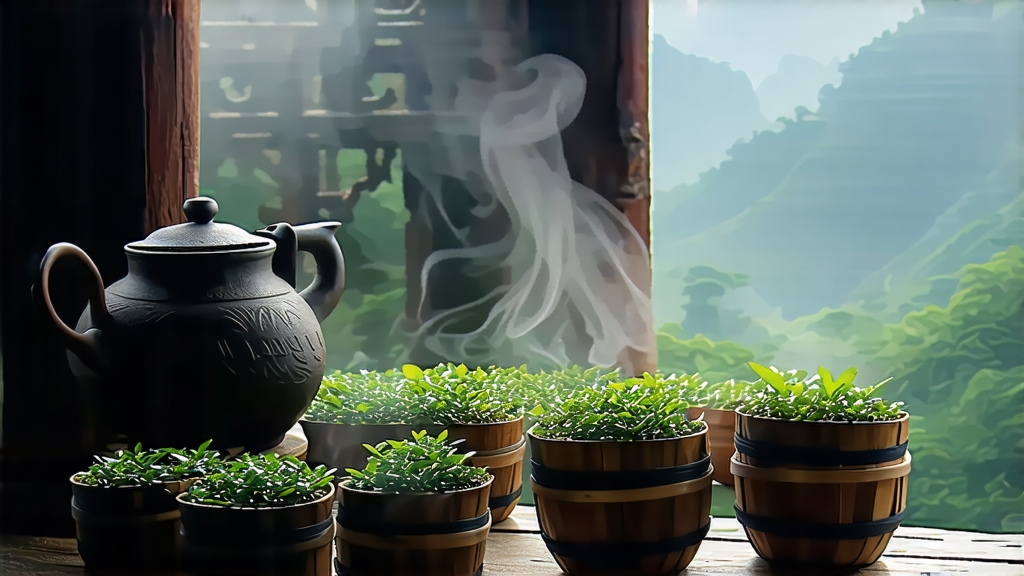
Tucked away in the humid, karst-pocked southwest of China, the small town of Liubao in Wuzhou, Guangxi, gave its name to a tea that once rode the Silk Road by mule and junk, paid imperial taxes in leaf, and still ferments quietly in bamboo baskets while the world argues over the definition of “dark tea.” Liu Bao is not as famous as Pu-er, yet it is older than many Yunnan recipes, and its flavor is a liquid atlas of subtropical forests, horse-sweat trails, and time itself.
History: From Imperial Tribute to Maritime Currency
The first written record appears in 1640, when the Guangxi provincial gazetteer lists “Liubao” among teas sent to Beijing as spring tribute. By the late Qing, British maritime logs note that Liu Bao was ballast in the holds of clippers leaving Guangzhou for Singapore and Calcutta; the compressed baskets absorbed bilge water, began a second, slow fermentation, and arrived smelling of damp wood and betel nut—an aroma that became the mark of authenticity. In the early 20th century, overseas Cantonese miners in Kuala Lumpur would pay their morning tab with a wedge chipped from a Liu Bao brick; the tea suppressed malaria and cut the grease of pork-laden breakfasts. When the Japanese blockaded the Pearl River in 1938, production collapsed, and Liu Bao retreated into village attics, where it slept for decades, waking only in the 1990s when Taiwan and Malaysia went searching for the taste of their grandfathers.
Leaf and Place: Micro-terroir in the Heat
The cultivar is a medium-leaf Camellia sinensis var. sinensis locally called “Zhong ye zhong,” thriving between 200–600 m on red lateritic soil under evergreen laurels. The monsoon delivers 1,600 mm of rain in four months, wrapping the bushes in a microbial cloud that already starts the tea’s transformation on the stem. Farmers pick one bud plus the third or fourth leaf—older, tougher foliage packed with polyphenols that feed the post-fermentation bacteria.
Craft: When Tea Meets Steam, Bacteria, and Bamboo
Withering is brief: two hours under shade to keep the leaf temperature below 30 °C. A 5-minute kill-green in a 200 °C wok halts oxidation but leaves a turquoise core. Rolling is done by foot on a rattan mat, the sole pressing just enough to fracture cell walls without crushing veins. The crucial step is “dui zi” (piling): leaves are heaped 70 cm deep inside bamboo steamers lined with banana leaf; the core temperature climbs to 55 °C in 24 hours, activating Aspergillus niger and Bacillus subtilis that convert catechins into theaflavins and gallic acid, giving Liu Bao its characteristic sweet-sour note. After three turns and six days the leaf is jet black with chestnut edges; it is sun-dried for only two hours—just enough to reach 12 % moisture—then packed, while still warm, into 50 kg cylindrical bamboo baskets called “long lan.” These baskets breathe; over years the tea re-absorbs ambient humidity, continuing fermentation in a cycle of wetting and drying that can last half a century. A 1970s basket recently opened in Kuala Lumpur registered a moisture content of 18 %, yet the liquor was bright maroon, proof that the microbes had kept pathogens at bay.
Grades and Shapes
Traditional grades follow leaf size: “Te Ji” (special grade) is 30 % tips, 70 % second leaf; “Yi Ji” (first grade) allows the third leaf; “San Ji” (third grade) includes stems and yields a coarser, more camphoraceous cup. Modern factories also press the tea into 100 g mini-bricks for the gift market, but connoisseurs prefer the loose “san cha” from the basket, where air has sculpted the flavor.
Aging: The Humid Symphony
Unlike dry-stored Pu-er, Liu Bao needs humidity—70–85 % RH is ideal. In Liubao, villagers slide baskets under the raised wooden granary; in Hong Kong, traders stack them in windowless rooms with open jars of water. The tea drinks the air, swelling and contracting, exhaling aromas of jujube, nutmeg, and old incense. A ten-year Liu